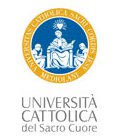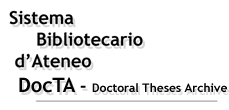|
|
DocTA - Doctoral Theses Archive >
Tesi di dottorato >
CORSO DI DOTTORATO IN SCIENZE DELLA PERSONA E DELLA FORMAZIONE >
Citazione:
Utilizza queste indicazioni per citare o creare un link a questo documento.
|
Schieppati, Sara Valentina. "ART AS HUMAN REFLECTIVE PRACTICE", Università Cattolica del Sacro Cuore, XXXV ciclo, a.a. 2021/22, Milano, [http://hdl.handle.net/10280/148708].
|
| Titolo: | ART AS HUMAN REFLECTIVE PRACTICE |
| Autore/i: | SCHIEPPATI, SARA VALENTINA |
| Tutor: | GILLI, GABRIELLA
CAPRIO, SANTIAGO |
| Coordinatore: | MARCHETTI, ANTONELLA |
| Lingua: | ENG |
| Abstract in italiano della tesi: | L'arte è una pratica umana di riflessività che si può trovare in diversi contesti e gli studi presentati lo dimostrano. Il primo capitolo presenta una panoramica dell'arte visiva nelle religioni monoteiste e indaga i legami tra arte religiosa e psicologia. Nel secondo capitolo, la ricerca indaga i giudizi estetici e di vitalità di volti che rappresentano morti, Santi e non Santi. I risultati mostrano che i Santi sono stati giudicati più belli, mentre i non Santi sono stati giudicati più vitali. Questo suggerisce una relazione tra etica ed estetica anche nella percezione dell'arte. Il terzo capitolo esamina il rapporto tra arte, robot ed esseri umani. Credere che l'opera d'arte sia stata creata da un robot, piuttosto che da un essere umano, influisce sulla valutazione estetica? La ricerca ha dimostrato che i dipinti che le persone credono siano stati realizzati da esseri umani ricevono un alto apprezzamento estetico, mentre i dipinti che le persone credono siano stati realizzati da robot ricevono un basso punteggio di competenza artistica. Da questi risultati, l'arte viene vista come un'abilità puramente umana. |
| Abstract in inglese: | Art is a human practice of reflexivity that can be found in different contexts, and the studies presented demonstrate this. The first chapter presents an overview of visual art in monotheistic religions and investigates the links between religious art and psychology. In the second chapter, the research investigates the aesthetic and vitality judgments of faces representing dead, Saints and non-Saints. In the results, Saints were judged more beautiful while non-Saints were judged more vital. This suggests a relationship between ethics and aesthetics in the perception of art. The third chapter examines the relationship between art, robots, and humans. Does believing that artwork was created by a robot, rather than a human, affect aesthetic evaluation? The research showed that paintings that people believe were made by humans receive high aesthetic appreciation, while paintings that people believed were made by robots receive low artistic competence scores. From these results, art is seen as a purely human skill. |
| Digital Object Identifier (DOI): | https://doi.org/10.3390/bs12120507
https://doi.org/10.3280/rip2022oa13589 |
| Data di discussione: | 26-giu-2023 |
| URI: | http://hdl.handle.net/10280/148708 |
| Indirizzo URL alternativo: | https://www.mdpi.com/2076-328X/12/12/507
https://journals.francoangeli.it/index.php/ripoa/article/view/13589 |
| È visualizzato nelle collezioni: | CORSO DI DOTTORATO IN SCIENZE DELLA PERSONA E DELLA FORMAZIONE
FACOLTA' DI SCIENZE DELLA FORMAZIONE
|
File in questo documento:
| File |
Descrizione |
Dimensioni | Formato | Accessibilità |
|---|
| tesiphd_completa_Schieppati.pdf | Tesi completa | 1,52 MB | Adobe PDF | non consultabile
|
| 01_frontespizio_tesiphd_Schieppati.pdf | frontespizio, indice, abstract, introduzione | 323,31 kB | Adobe PDF | Visualizza/apri
|
|
Accesso e utilizzo dei contenuti di DocTA
|



